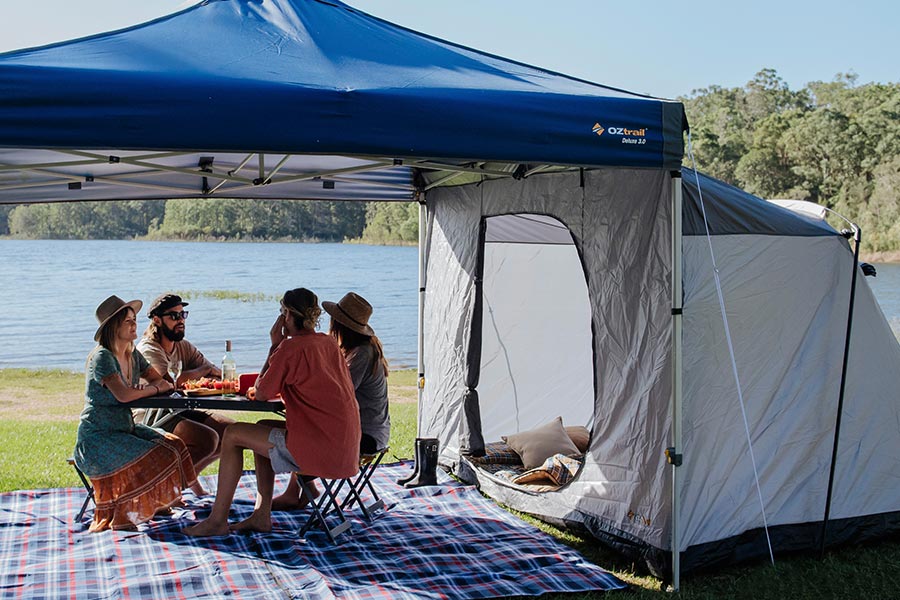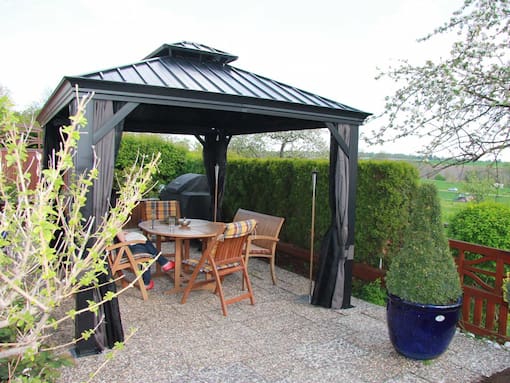
You have chosen an aluminum pavilion, steel or folding pavilion and do not want to worry about your new sun and rain protection even in windy conditions? Then it is best to fasten the pavilion to the ground. We show you how it works!
Fixing the pavilion without drilling
If you have a folding gazebo that you only set up as needed for barbecues and garden parties, then fastening it is particularly easy: without drilling – with ground anchors, pegs or feet.
But note that you can not fix garden gazebos without drilling in the long term.
Fastening with ground anchors and cords
Folding gazebos can be fastened by means of anchors in the lawn or other soft ground. The necessary stability is provided by pegs, ground anchors and cords with which you can secure the pavilion. Your advantage: The folding pavilion can be flexibly erected and dismantled.
Ground anchors serve as fixed points for absorbing tensile loads. Folding pavilions and tents can be tied to them. Depending on the ground conditions, different ground anchors are suitable for pavilion fastening. Impact anchors are pointed, sometimes have barbs and are driven directly into hard and stony ground with a hammer.
Bolted ground anchors can be twisted into the earth until only the eyelet is visible, to which you attach the tensioning cords. The wider the thread, the deeper the screw in the ground, and the firmer the ground itself, the tighter the ground anchor will sit in the ground. In non-consolidated soil and loosely backfilled soil, screwed anchors therefore do not grip reliably. These ground anchors are also difficult to screw into stony ground. Most mygardenhome.de folding pavilions already come with suitable anchors.
But even with the right pegs and ground anchors you can anchor folding pavilions only for a short time. Because at the latest when rain falls over a longer period of time, the ground softens and the anchors lose their grip.
What you can do if pegs and anchors can not be driven into the lawn?
If the ground is simply too hard or you want to place the gazebo on rock, you need to create alternative fixed points. For example, set up gazebo weights as counterweights and brace the gazebo to them.
Tip for storms:
If strong wind goes, you can anchor folding gazebos and party tents with storm protection. In this case, the gazebo is not braced with thin cords, but robust tension straps to the ground anchors for more stability.
Fastening with ballast bags
Do you want to avoid tripping hazards at your garden party and fix the gazebo without cords and straps? Then use ballast bags to fix the garden pavilion at the desired location.
Ballast bags are hollow and enclose the legs of the folding gazebo. Fill the hollow space with water or sand to weigh down the gazebo. Use water to increase the weight of the gazebo by about 9 kg per stand and sand to increase the weight by about 15 kg. If you mix the two fillers, the ballast bags can become even heavier. Therefore, do not fill the ballast bags until the pavilion is in the desired location and no longer needs to be moved.
_510x383.jpg)
Fastening pavilion with screws
Fastening with ground anchors, tension ropes and feet is only suitable for short-term and flexible use of folding pavilions and party tents. For aluminum and steel pavilions with heavy weight, this fixing method is not stable enough.
For aluminum and steel gazebos, fasten the legs to a foundation with screws. The sturdy gazebos are designed for year-round use, can be safely wintered outside and do not need to be dismantled seasonally.
However, if you ever want to buy a new pavilion, the holes for the screws in the foundation may no longer fit the new model. Then you need to close them and drill new holes.

The right foundation for the gazebo
If you want to place your gazebo on a lawn and feel the grass on your feet even under the gazebo roof, then you need a point foundation. In this case, you pour a foundation for each leg and thus fix the gazebo point by point. A point foundation can be easily completed in four steps:
Level the ground, mark out the pavilion floor plan and mark the foundation points.
Dig holes at least 80 cm deep and 20 cm wide where the legs will later stand.
Mix the concrete and pour it into the holes.
Keep compacting the concrete and smoothing the surface with a trowel.
For wooden posts, avoid direct contact with the ground and concrete and place the posts on post anchors or post shoes. The mygardenhome.de garden gazebos are already supplied with feet or post plates, which can be screwed to the foundation.
Attach gazebo to foundation and house wall
Once the foundation is poured and hardened, you can attach the gazebo to it. By the way, the same procedure works if you use an existing patio as a foundation and screw the gazebo to it.
Drill holes in the foundation and feet, sink dowels into them and screw the two components together using screw brackets. By the way, you do not need screw angles for the pavilions from mygardenhome.de. The post plates have pre-drilled holes through which they can be screwed to the foundation.
Some gazebos even have tabs specially attached for wall mounting
Fastening by pavilion type
Folding gazebos and party tents can be easily fastened with pegs, ground anchors, cords, stand feet – and in case of strong wind – with storm protection. If the ground softens, for example, due to prolonged rainfall or otherwise loosens over time, these methods of attachment will no longer provide sufficient support. However, because folding pavilions are not designed for continuous use, you can temporarily use ground anchors and the like for fastening these pavilions without any problems.
However, for pavilions made of steel and aluminum, this method of fastening is not enough. These weather-resistant models must be permanently fixed to the terrace by means of a point foundation or screws. Your advantage: the pavilion can stay in your garden as long as you want.
Properly fixed gazebos bring a lot of joy
Sun-protected summer days, but also exuberant garden parties in wind and weather: If your garden pavilion is well fixed, you can enjoy the green oasis behind your house in any weather. Aluminum and steel gazebos are securely bolted to a foundation – and with folding gazebos, tensioning with ropes is sufficient.
Contents
Frequently asked questions
Here you will find answers to questions we are frequently asked.
Are the screws for anchoring to the ground included?
Our Palram pavilions come with a set of screws for anchoring to the ground, unlike the pavilions from the company Sojag and Paragon.
It is best to use standard 8mm dowels and 6mm screws for fastening.
How much wind can a gazebo withstand?
Different types of gazebos can withstand different wind forces. Pavilions that are firmly bolted to a foundation are much less sensitive to wind and storms than folding pavilions and party tents.
If in doubt, you should rather dismantle them.
How can I fix my pavilion on the terrace?
You can either secure a folding pavilion or a tent to the terrace with feet – or you can brace the party tent to alternative fixed points such as sand-filled buckets or trees. Steel and aluminum gazebos need to be bolted to the patio.
The gazebos from mygardenhome.com already have post plates with pre-drilled holes for this purpose, through which you can insert the screws.
Do I have to fix my gazebo to the ground?
In order to ensure a safe and solid stand of the gazebo, it is mandatory that the gazebo is fixed to the ground.
For this purpose, we advise you to fix the gazebo on a solid ground – preferably a foundation.

